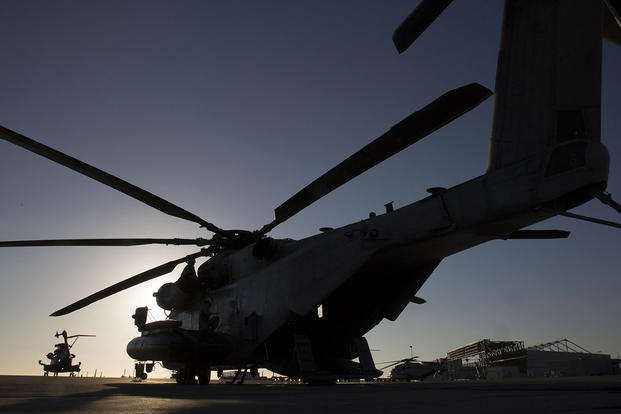A Marine Corps CH-53E Super Stallion collision off the coast of Hawaii in January that left all 12 Marines aboard dead was the result of an epidemic of low flight hours and subpar readiness rates across the fleet, the head of Marine Corps aviation told Military.com on Wednesday.
Speaking the day the Marine Corps was expected to release its full investigation into the tragic crash, Lt. Gen. Jon Davis said the probe found the aircraft themselves were in fine condition to fly for the Jan. 14 night training mission.
"I would actually say there shouldn't have been a mishap," Davis said. "If you read the investigation report, it's pretty clear that there were a lot of things that could have happened to stop it from happening and didn't happen, to include the recommendation of the safety officers involved not to fly the mission."
The pilots themselves were current on their training to fly the mission, but not as proficient as they would have been due to widespread shortfalls of available aircraft, leading to cutbacks in monthly flight hours.
Davis said the decision to relieve Lt. Col. Edward Pavelka, commander of Marine Heavy Helicopter Squadron 463, three days before the crash was tied to these key readiness concerns.
Both of the aircraft involved in the collision were from the Hawaii-based squadron.
"Even though the whole '53 fleet was suffering, they were suffering more than others," Davis said.
In a statement, a Marine Corps Forces Pacific spokesman, Lt. Col. Curtis L. Hill, confirmed that crash was the result of pilot error.
"Investigators believe that the low light conditions made it difficult for the aircrew to recognize the rapid decrease in separation between the aircraft, which led to the collision," he said. "Investigators found that all pilots and aircrew were qualified in accordance with regulations and standards and medically fit for duty … Investigators found the main contributing factors were low aircraft readiness leading to inadequate pilot proficiency, human factors, and the squadron's lack of focus on basic aviation practices."
Since the crash and the arrival of the new commanding officer, Lt. Col. Eric Purcell, the squadron's average pilot flight hours have more than doubled, due in significant part to a two-and-a-half-year effort to improve the readiness rates of the CH-53 and the Navy's MH-53E Sea Dragon.
Across the entire CH-53 fleet, Davis said, pilot flight hours have more than doubled. Meanwhile, he said, key equipment reset and maintenance has been completed, including replacement of aging wires and new fuel pipes.
"I've got a high degree of confidence that the material condition of these airplanes, and frankly these airplanes -- even the ones in the collision -- we don't believe there's anything wrong with them," he said. "We have better readiness now -- still not good enough, but we're working on it."
At their readiness nadir in 2015, only 23 percent of CH-53s were available to fly. The same year, pilots of the aircraft logged the fewest number of flight hours of any aviation platform since 1988, according to an investigation by the Virginian-Pilot.
The commandant of the Marine Corps, Gen. Robert Neller, told a congressional panel in March that commanders had kept the heavy-lift helicopters in theater "a little big too long" in Iraq and Afghanistan, leaving the platform overworked and badly in need of reset.
Ultimately, the Marine Corps plans to replace all its CH-53s with the brand-new CH-53K King Stallion now in testing. The first aircraft will be delivered to the service in 2019, and the transition is expected to happen over the next decade.
-- Hope Hodge Seck can be reached at hope.seck@military.com. Follow her on Twitter at@HopeSeck.



























